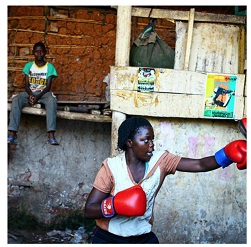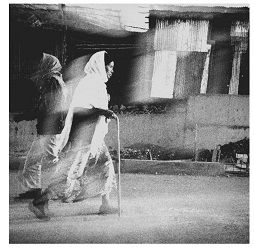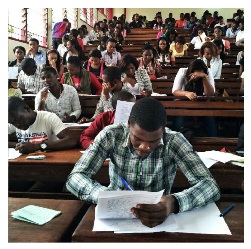By Conor Risch, guest writer
 When Peter DiCampo co-created Everyday Africa with Austin Merrill in March, 2012, he couldn’t have known how it would change his career from a focus on his own photography to working to amplify the voices of other photographers. Launched as a social media-based photo project that sought to combat clichés perpetuated by Western media coverage of Africa, Everyday Africa has spawned similar “Everyday” projects not only about other places, but also about critical social issues such as climate change and incarceration. Six years after the launch of Everyday Africa, DiCampo is co-president of The Everyday Projects, a non-profit organization that, among other things, promotes visual literacy to middle and high school students and gives workshops for a diverse new generation of visual storytellers. He’s also currently an artist in residence for the arts and culture organization Town Hall Seattle, working with the local community to program photography events for this spring. On March 27, Blue Earth Alliance photographer and board member Deborah Espinosa will present her project “Living with Conviction: Sentenced to Debt for Life in Washington State,” and another yet-to- be-announced event will feature a number of photographers associated with The Everyday Projects. Click for details on this event.
When Peter DiCampo co-created Everyday Africa with Austin Merrill in March, 2012, he couldn’t have known how it would change his career from a focus on his own photography to working to amplify the voices of other photographers. Launched as a social media-based photo project that sought to combat clichés perpetuated by Western media coverage of Africa, Everyday Africa has spawned similar “Everyday” projects not only about other places, but also about critical social issues such as climate change and incarceration. Six years after the launch of Everyday Africa, DiCampo is co-president of The Everyday Projects, a non-profit organization that, among other things, promotes visual literacy to middle and high school students and gives workshops for a diverse new generation of visual storytellers. He’s also currently an artist in residence for the arts and culture organization Town Hall Seattle, working with the local community to program photography events for this spring. On March 27, Blue Earth Alliance photographer and board member Deborah Espinosa will present her project “Living with Conviction: Sentenced to Debt for Life in Washington State,” and another yet-to- be-announced event will feature a number of photographers associated with The Everyday Projects. Click for details on this event.
DiCampo was a featured speaker at the February Blue Earth Alliance happy hour, so we reached out for a follow-up discussion about some of the ideas affecting photojournalism today, and about how The Everyday Projects is helping to promote different modes of storytelling from a diverse range of photographers.
Conor Risch: Institutional bias in journalism—its white-male perspective—is a topic that’s getting a lot of attention right now. I’m curious what you’ve learned in creating The Everyday Projects about what it takes to break down biases?
Peter Di Campo: We often operate with this idea that if journalism were perfect, then no matter who the storyteller was, the story would always come out the same. Going by the same set of rules, we would all approach it the same way as far as what’s most to least important about this story. I just find that to be so constricting and also so false.

That’s what I’m constantly thinking about and constantly trying to promote, is the idea that communication is never going to be perfect. Diversity, inclusion—these things, there’s no perfect way to do them, but there are big steps that we can take and seeing a variety of stories told in a variety of ways helps to broaden our understanding.
We’re in a really strange and interesting period right now where we’ve gone from having [nightly news broadcasts hosted by] Jennings and Brokaw and Rather—and having those be the three places you got your news and you trust them absolutely until you realize that you don’t—to everyone’s got a voice and we don’t really know who to trust. It’s a strange time to think about how we blend the multitude of voices. I don’t trust everyone that’s got a blog by any stretch of imagination, but I also think there was an inherent tyranny in the old system. I won’t pretend to have the answers, but I think that’s the moment we’re in: how do we listen to the multitude but also maintain journalistic integrity?
Risch: I also wonder how much the economics of journalism are affecting the push to diversify. Despite positive discussion about the need for journalism to shed its white maleness, I wonder if the economic pressure also works against diversity, because when money is tight, editors stick to veterans rather than giving opportunities to newcomers.
Di Campo: These are the questions that plague me and there’s certainly no easy answers. I’m involved in a lot of teaching at workshops, teaching at master-classes, The Everyday Projects and the organization Native Agency just started a mentorship program. I catch myself in the midst of all this thinking: What are we preparing these people for? Are we just getting them ready to take that one New York Times assignment in their country in a given year instead of me taking that assignment, and how does that really help?

I do see some people thriving, finding multiple assignments. And of course—this is not limited to the Western part of the world, this is everywhere—photographers are making it by also doing corporate jobs and also doing advertising and so on and so forth, but it’s tough. It’s really hard to have a frank conversation about these things. Sometimes if you bring up the economic issues then the people who are struggling to get a foothold say that you’re against them. It’s hard to figure out how best to provide opportunities for people in a real way that will be long- lasting in a [profession] where many people don’t see a career anymore. There’s no easy answers.
Risch: The Everyday Projects has the support of major non-profit journalism organizations and the Everyday work has been published in some of the leading news outlets in the world. In your opinion, how much progress has been made in recent years in breaking down institutional bias, and what more needs to be done?
Di Campo: If you look at the statistics that the group Women Photograph has—they keep careful track of how many front pages are photographed by women in the major newspapers—or if you look at the World Press Photo results that just came out—I think World Press Photo has done a great job of trying to promote diversity and yet the entrants to the contests are just as [white and male] as ever. You see a lot more things that are specifically geared towards getting non-white men out there shooting, but it still seems that the majority of the stories that we hear are from the usual suspects. I actually think there’s a lot more to do.
Risch: I occasionally judge competitions, and it seems to me that a lot of photographers feel that in order to do “serious journalism” they not only need to tell stories about societies far removed from the ones they live in, but they also have to focus on poverty, violence and human suffering in developing countries or minority communities. Do you think The Everyday Projects offer a counterpoint to that way of thinking?
Di Campo We are big supporters of both insider and outsider storytelling. We’ve embraced [the idea that] both of those things have limitations. They’re more obvious if you’re an outsider: The idea that you won’t necessarily understand the nuance of the situation, you won’t know the customs you’re supposed to follow—there are just so many things. But if you’re an insider, then you’re often blinded to things as well. It might be more difficult for you to be critical of your own culture or whatever it is.

I always point to Robert Frank; it’s not as good a comparison as it would be if Robert Frank were say, African; Switzerland and America are maybe not the most different places in the world. But still, he was not an American but he came and made this classic body of work. Having said that, we’ve been thinking about it more and more, that The Everyday Projects has two goals: There’s middle school and high school education, and then there’s a section of what we do that supports photographers. And the line of thinking there is that it’s about us trying to change the stories that are out there, and in some ways that involves supporting a change of who the storytellers are. Taking Everyday Africa as an example, there are plenty of Western photographers who are part of Everyday Africa, you don’t have to be African to change the story that’s being told, but it just became more and more obvious to us that supporting those [local] storytellers is a big part of it. So we are trying to support more and more people who are interested in self-representation and stressing the importance of documenting one’s own community.
Risch: I’m glad you mention education. How does what you’re teaching journalists via The Everyday Projects differ from your own journalism education?
Di Campo: I’ve got to mentally dig back to 2004. One obvious [example] is the absence of social media when I was in college. There was less discussion of self-representation. Maybe in some ways that was the beginning of the modern era of people distrusting journalists, which, while we don’t want to play into that in the fake news, Trumpian style, in some ways I see [The Everyday Projects] as an antidote to people feeling disenfranchised by media.
Going beyond that, I feel like I learned journalism in this hardcore set of rules way that didn’t necessarily involve talking about respect for your subjects or things like that.
Conor Risch is a Seattle-based writer and senior editor of Photo District News (PDN). Follow him on Twitter @c_risch.